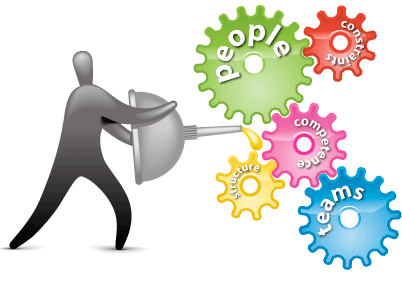 tl;dr: good conflict
tl;dr: good conflict
- Assume you are only partially right. And then stay curious and see how others are right. (A mind congealed is like frozen water. Unable to be used freely.)
- Make sure you agree on the problem you are trying to solve.
Conflict drives innovation
To effectively drive innovation, we have to know how to have a healthy exchange of ideas – different and often opposing ideas. Assemble those, add a few hundred pounds of creative talent and voila we get conflict. And believe it or not, that can be a good thing. Conflict itself is not dangerous or dysfunctional. (However, how we react to it can be.)
The kind of conflict I’m referring to here is not the nasty kind that centers around people or personalities. Rather, it is productive ideological conflict, the willingness to disagree, even passionately when necessary, around important issues and decisions that must be made.
This kind of conflict is not as something to be avoided, but instead is a valuable resource. Conflict offers us the possibility of seeing things differently and is a catalyst for individual and organizational learning.
It has been said that a team in perpetual harmony is a team that is not performing to its highest potential….
“Find more pleasure in intelligent dissent than in passive agreement, for, if you value intelligence as you should, the former implies a deeper agreement than the latter.” Bertrand Russell Click To TweetHow to have good conflict
Assume you are only partially right. Click To TweetLevels of conflict
Lyssa Adkins provides a useful map of the different levels of conflict individual and teams can experience, and the language that you’re likely to hear at each, (Level 1 being “healthiest.”)
- Problem to solve: constructive, open language, fact based, sharing and collaborative. Sounds like: “yes, and“
- Disagreement: blame shifting, guarded language, which is open to interpretation, personal protection over collaboration. Sounds like: “no, but”
- Contest: personal attacks: “You always…” “He never”
- Crusade: entrenched opinions, idealogical language: “only my way will work…”
- World war: destruction, us vs them, little exchange: “you are an idiot”
The “ingredients of an interaction”
By listening to the “language of a conflict,” one can learn to see clearly where things are at the moment.
And if things have escalated beyond Level 1, anyone can help bring things back often simply by asking the question: “Do we agree on what is the problem we are trying to solve?”
How do things escalate in the first place? Communication can go astray for all sorts of reasons. A listener misunderstands a word, remembers a similar conversation from the past and misinterprets the new message, or concludes how the message will end before the speaker has even finished. The list of reasons for communication problems is endless.
A listener passes a message through several stages before he or she can fully understand and respond to it. Often this happens in microseconds. At each stage, the listener engages in important analysis of the message:
- Intake. The listener analyzes what he or she saw and heard about the message.
- Assign a meaning. The listener determines a meaning using the analysis from the intake stage.
- Determine a feeling, assign significance. The listener develops a feeling in response to the message (for example, he or she feels hurt, disappointed, proud, surprised, confused, or some other emotion) based on intake, meaning and past experience.
- Identify a feeling about the feeling. After the listener has identified the initial feeling, he or she reacts to the feeling. For example, if the listener has been paid a compliment and feels proud, how does he or she feel about feeling proud? Embarrassed, ashamed, or complimented are all possible emotions and these may color how he or she responds to the message.
- Develop a response. The listener formulates a response.
Each of the four stages adds to the process of how a listener understands a message and prepares a response. Messages become confused when a listener either misinterprets or skips one or more of the four stages. Success in the final stage is dependent on the first four stages of analysis. (And again, the first four steps can happen in a flash.)
Simply ask the question: Do we agree on what is the problem we are trying to solve? Click To TweetAs a participant (or an observer) of an interaction, you can use your awareness of this model to help redirect communication that has gone astray. If someone responds in a way that doesn’t make sense, stop and ask what might have happened. Perhaps the listener processed the message incorrectly, but in the most extreme of conflicts, you can find out exactly what’s happening by stopping the dialogue, asking the speaker to repeat the message, and walking the listener through each of the five stages.
Share and collaborate
To take advantage of the possibilities that a “conflict” situation presents the participants must first feel safe and trust each other. When there is trust, conflict becomes nothing but the pursuit of truth, an attempt to find the best possible answer to solve a particular problem. Conflict without trust descends into politics or a clash of personalities.
For healthy conflict, all parties must (at least temporarily) suspend any assumption that “I am right.” Note that this is not about discounting your own evaluation, or assuming you or “the other side” are “wrong” – rather it is about holding more than one simultaneous reality. Challenge yourself to consider the follow propositions:
- Can I state/clarify the problem we are trying to solve? Does everyone agree that is the problem to solve?
- There is probable merit to my perspective or solution to the problem we are trying to solve.
- My perspective may not be accurate. Acknowledge the difference between opinion and fact. Many discussions get heated because people tie themselves to opinions.
- There is some coherence, if not merit, to the other person’s perspective.
- There may be more than one legitimate interpretation.
- The other person’s view of my viewpoint is important information for my assessing whether I am right or identifying what merit there is to my view.
- Our conflict may be the result of the separate commitments each of us holds, including commitments we are not always aware we hold.
- Both of us have something to learn from the conversation.
- We need to have two-way conversations to learn from each other.
- If contradictions can be a source of our learning, then we can come to engage not only internal contradictions as a source of learning but interpersonal contradictions (conflict) as well.
- The goal of our conflict is for each of us to learn more – about ourselves as well as the other.
- Accept, and practice, changes of position and opinion as new information arrives.
Practicing this approach does not mean heading down a road of paralysis by analysis. Instead, it is an exploration and testing by all parties of the key assumptions underlying their positions. Enabling a meaningful decision about how to carry on rooted in shared learning.
The purpose of this approach is not to make conflict disappear or reduce its intensity. In fact it is likely that it will lead to more conflict and a richer context for learning.
We will make decisions a number of different ways. In some cases we will abide by decisions made by the most qualified member of the team. In other cases, we will vote. In some cases when everyone’s support for the decision is critical we will decide through consensus (See Note and Vote)
And ultimately we can agree to disagree and still move forward with collective commitment and with the full benefit of the wisdom of the group.
A mind congealed is like frozen water. Unable to be used freely. Click To TweetCrucial Conversations
The book: Crucial Conversations: Tools for Talking When Stakes are High discusses how to handle disagreements and high-stakes communication. It is written on the premise that when you are stuck in any situation – whether it’s at home or work – there is a crucial conversation keeping you from accomplishing the desired results. If you can learn to speak up in these crucial moments effectively, then you can accomplish the results you are after.
There’s a simple three-step you can try the next time you have a difficult conversation:
- State how you feel
- State what you need
- Ask the person you are having the conversation with “What do you need?”
Additional Reading
- Lyssa Adkins, http://www.agilecoachinginstitute.com/ and Coaching Agile Teams
- The High Professional Cost of Your Inability to Trust
- Helping Others Deal with Conflict
- Radical Candor



